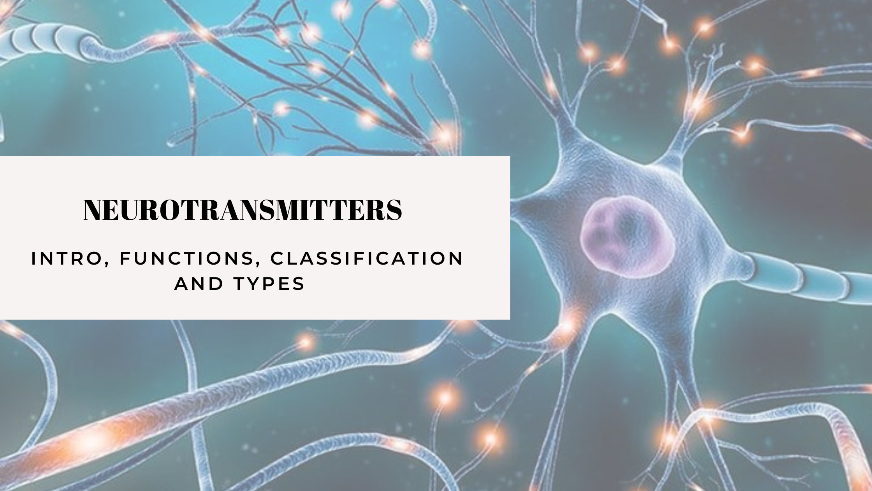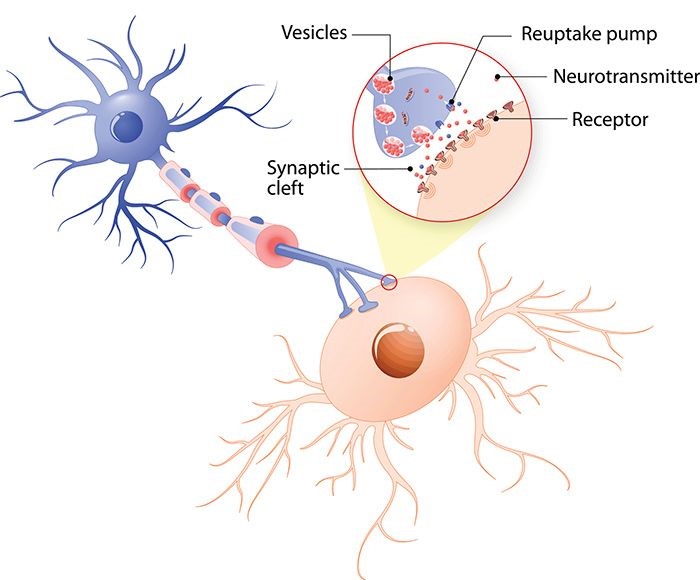
Introduction to Neurotransmitters
Our body has a vast network of nerves, known as the nervous system, which includes the brain, spinal cord, and neurons. This system controls and coordinates all body activities, regulating basic functions like breathing and heart rate, as well as complex processes like thinking, learning, and emotions.
Neurotransmitters are the chemical messengers of the nervous system, playing a crucial role in transmitting signals between neurons (nerve cells) and other cells in the body. These cells may be located in glands, muscles, or other neurons. These billions of molecules are essential for coordinating various bodily functions, including regulating mood, behavior, cognition, and bodily processes like breathing, heartbeat, blood pressure, and muscle movements.
Thus, Neurotransmitters play a vital role in allowing for communication within the brain and between the brain and the rest of the body.
How do Neurotransmitters Work?

When a nerve cell wants to send a message to another nerve cell, it releases neurotransmitters into a tiny gap between the cells called a synapse. These neurotransmitters then travel across the synapse and attach to special proteins called receptors on the receiving nerve cell.
When the neurotransmitters attach to the receptors, they can either excite the receiving cell, cause an electrical signal to be transmitted down the cell (excitatory), or inhibit it, blocking the signal from being carried on (inhibitory).
After the neurotransmitters have delivered their message, their activity is terminated by the following three mechanisms:
- Reuptake: The neurotransmitter is taken back up into the presynaptic neuron that released them.
- Degradation: They are broken down by enzymes in the synapse so they can’t be recognized or bind to the receptor cell.
- Diffusion: They simply diffuse away from the synapse into the surrounding fluid.
Classification of Neurotransmitters
Neurotransmitters can be classified based on their functions into the following categories:
- Excitatory neurotransmitters
The neurotransmitters increase the likelihood that the postsynaptic neuron will fire an action potential or electrical signal. Examples of these types of neurotransmitters are epinephrine and norepinephrine.
- Inhibitory neurotransmitters
These neurotransmitters decrease the likelihood that the postsynaptic neuron will fire an action potential. Examples of these types of neurotransmitters are serotonin and gamma-aminobutyric acid (GABA).
- Modulatory neurotransmitters
The neuromodulators can affect many neurons at the same time, they do not directly excite or inhibit neurons but instead influence the effect of other neurotransmitters. Examples of these types of neurotransmitters are acetylcholine, dopamine, serotonin, histamine, and cannabinoids.
Major Types of Neurotransmitters and Their Effects
There can be almost 100 types of neurotransmitters and more might yet to be discovered, however, they can be categorized based on their molecular structure and the most common ones are the following:
Amino Acid Neurotransmitters
- Gamma-aminobutyric acid (GABA): The most abundant inhibitory neurotransmitter in the central nervous system. It plays a crucial role in calming things down in your brain. It reduces the excitement of nerve cells, helping to keep your brain balanced and functioning smoothly. Low GABA levels are associated with various neurological and psychiatric disorders like anxiety disorders, sleep disorders, and mood disorders such as depression and bipolar disorder.
- Glutamate: The most abundant excitatory neurotransmitter in the brain, plays a crucial role in cognitive functions such as memory and learning. Imbalances in glutamate levels are associated with Alzheimer’s disease, dementia, Parkinson’s disease, and seizures.
- Monoamine Neurotransmitters
- Dopamine: The feel-good neurotransmitter, commonly involved in reward-motivated behavior, motor control, mood regulation, and cognition. Imbalances in dopamine levels lead to Parkinson’s disease, schizophrenia, bipolar disease, restless legs syndrome, and attention deficit hyperactivity disorder (ADHD).
- Serotonin: an inhibitory neurotransmitter, involved in mood regulation, appetite, sleep, sexuality, and cognition. Imbalances in the serotonin levels are linked to conditions such as depression, anxiety disorders, and sleep disturbances.
- Norepinephrine: Also known as Noradrenaline, is a naturally occurring chemical released in response to stress or danger. It plays a crucial part in helping the body with the fight-or-flight response. It also helps in regulating mood, attention, and arousal. Imbalances in norepinephrine levels may lead to depression, anxiety, addiction, substance abuse, etc.
- Epinephrine: Also known as adrenaline, is a hormone and neurotransmitter that plays a crucial role in the body’s response to stress and emergencies. It helps prepare the body for “fight or flight”. They are released by the adrenal glands in response to stress. Abnormal levels are linked to sleep disorders, anxiety, hypertension, and lowered immunity.
- Peptide Neurotransmitters
Peptide neurotransmitters, also known as neuropeptides, are composed of short chains of amino acids, the building blocks of proteins.
- Endorphins: Often referred to as the body’s natural painkillers. They are involved in reducing the perception of pain and promoting feelings of pleasure and well-being. Activities that are known to increase endorphin levels include exercise, laughter, and certain foods. The release of endorphins during these activities is often referred to as the “runner’s high” or the “feel-good” effect.
- Oxytocin: Oxytocin is often referred to as the “love hormone” or “cuddle hormone” because of its role in social bonding, trust, and maternal behavior. It is also involved in the regulation of emotions and stress responses.
- Acetylcholine (ACh)
The excitatory neurotransmitter is found in both the central nervous system (brain and spinal cord) and the peripheral nervous system (nerves that branch from the CNS). It plays a major role in muscle contractions, memory, motivation, sexual desire, sleep, and learning. An imbalance in ACh levels can lead to various health issues like Alzheimer’s disease, seizures, and muscle spasms.
Neurotransmitters vs Hormones
Neurotransmitters are chemical messengers produced by the nervous system to transmit signals between neurons (nerve cells) and other cells in the body. They are released from the presynaptic neuron into the synapse (small gap between two adjacent neurons) and move to the next neuron, the postsynaptic neuron.
Hormones are chemical messengers produced in the endocrine glands and released into the bloodstream, to travel to different parts of the body, where they help regulate physiological as well as psychological health.
NEUROTRANSMITTERS | HORMONES |
Produced in the nervous system | Produced in the endocrine system |
Released from the presynaptic neuron into the synapse. | Released into the bloodstream.
|
They usually act on neighboring neurons or muscle cells. | They act on distant target cells throughout the body |
They have rapid and short-lived effects on the body | They have slower and long-lasting effects on the body |
Ex. Dopamine, Endorphins, Serotonin, Glutamate, etc | Ex. Androgens, Estrogens, Melatonin, etc |
Hence, neurotransmitters play a crucial role in our physical as well as mental health. Imbalances in neurotransmitter levels, such as serotonin, dopamine, and norepinephrine, are often associated with conditions like depression, anxiety, and schizophrenia. These imbalances can result from genetic factors, environmental influences, or lifestyle choices. Understanding the role of neurotransmitters in our health is essential for developing effective treatments and improving the lives of those affected by these disorders.
Blog By : DEEBHA SITHTA

